Abstract
The significance of hyperamylasemia and its relationship to pancreatitis after cardiac surgery is controversial. Three hundred consecutive patients undergoing cardiopulmonary bypass were prospectively studied to determine the incidence and significance of postoperative hyperamylasemia. Ninety-six of three hundred patients (32%) developed hyperamylasemia. Fifty-six patients (19%) were classified as having isolated hyperamylasemia because they were asymptomatic and had normal serum lipase. Thirty-two patients (10.7%) had subclinical pancreatitis defined as elevation of serum amylase and lipase or pancreatic isoamylase. Many of these patients had mild gastrointestinal symptoms that were self-limited. Eight patients (2.7%) had overt pancreatitis documented by clinical findings, biochemical abnormalities, and computed tomography (CT) scan or autopsy. Isoamylase analysis demonstrated that isolated hyperamylasemia usually originated from nonpancreatic sources. However, hyperamylasemia occurring in conjunction with abdominal signs and symptoms or elevated serum lipase was almost always pancreatic in origin. Patients with hyperamylasemia had a significantly higher mortality rate (seven of 96 patients, 7.5%) than those with normal serum amylase (two of 204 patients, 0.9%) (p less than 0.01) even when the amylase was nonpancreatic in origin (five of 56 patients, 9%). The reason that nonpancreatic hyperamylasemia is associated with increased postoperative mortality is not established but may represent a variety of metabolic aberrations or tissue injuries. It is concluded that 1) hyperamylasemia after cardiopulmonary bypass is a marker of potential clinical importance, and 2) pancreatitis in this setting is more common than previously recognized and is a potentially lethal complications. Successful treatment depends on early diagnosis and aggressive treatment.
Full text
PDF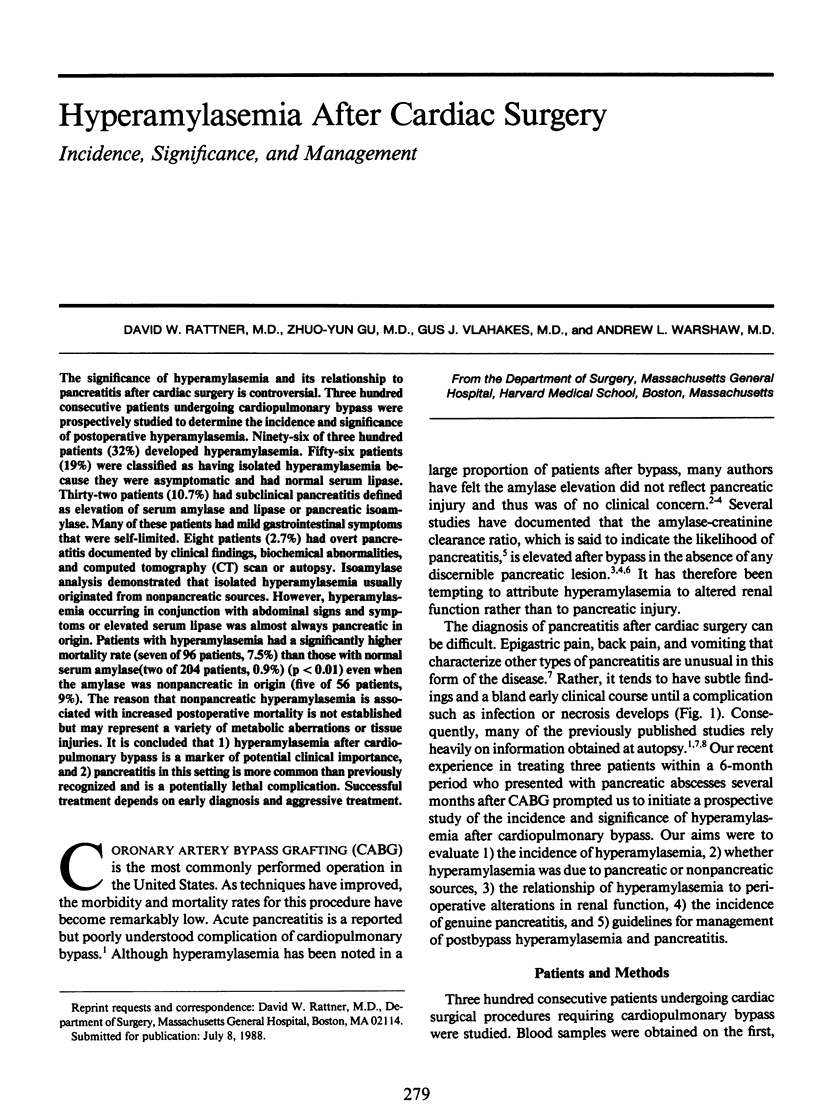
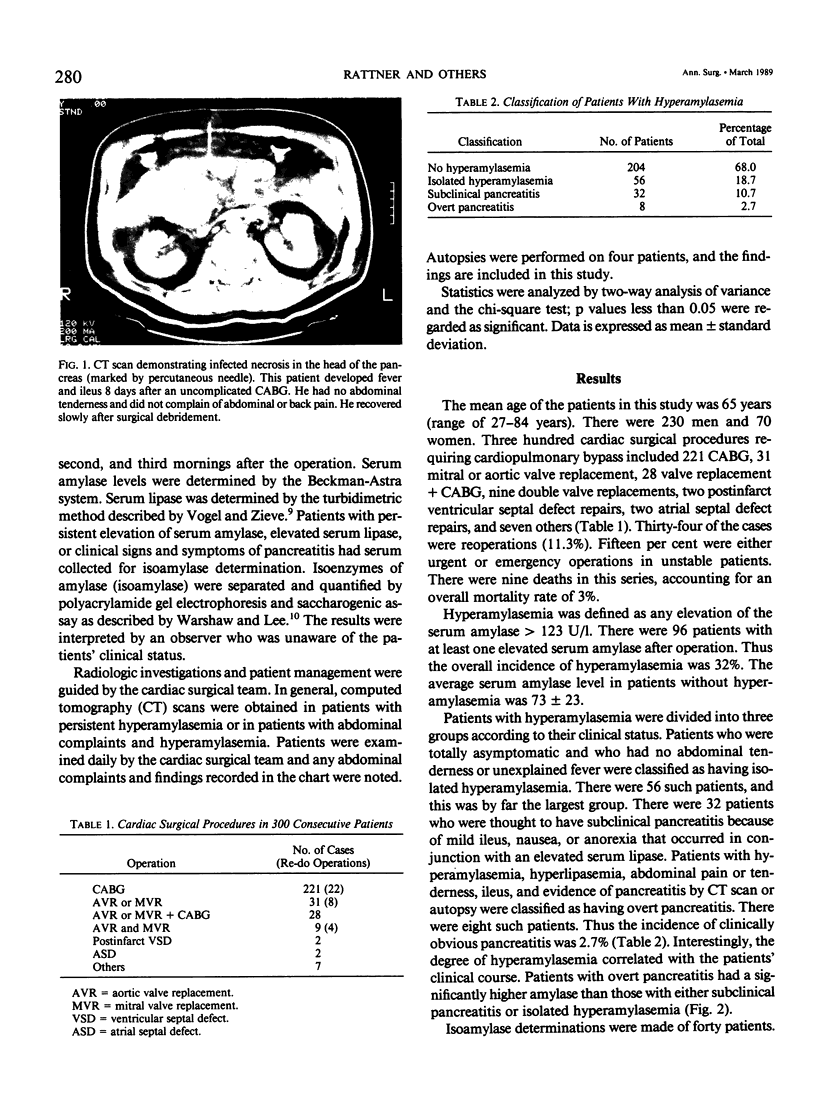
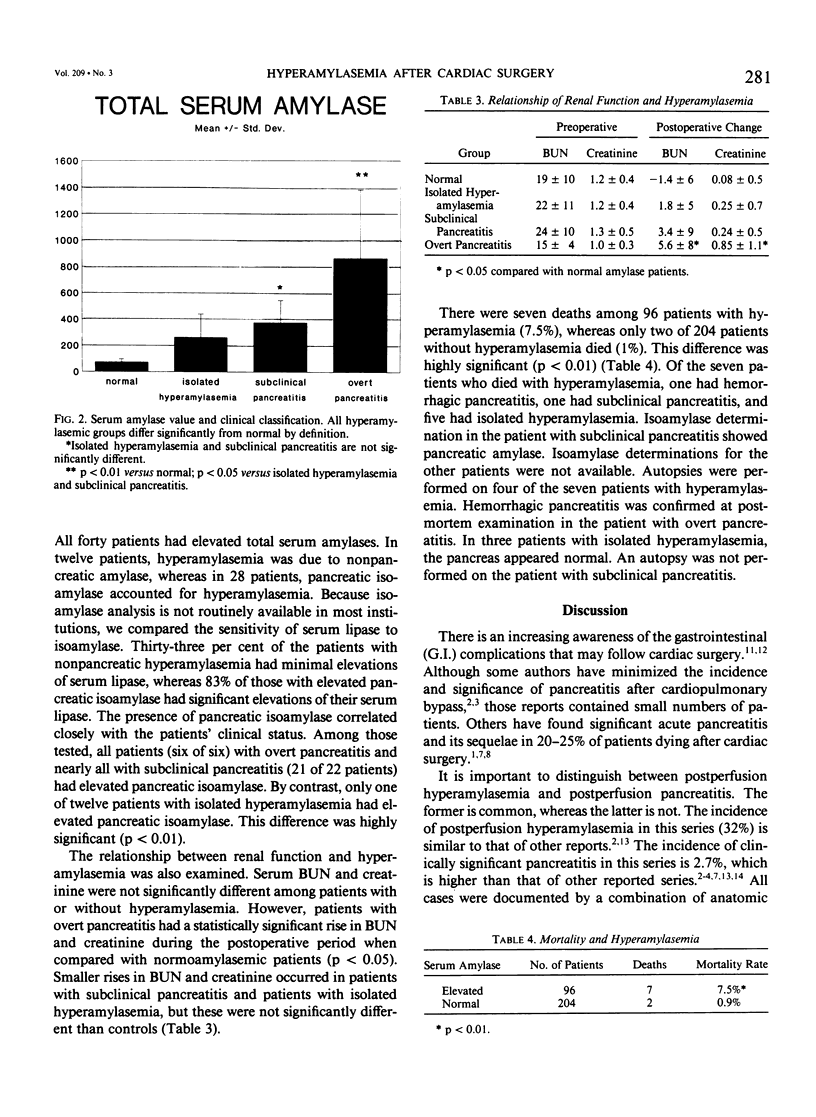
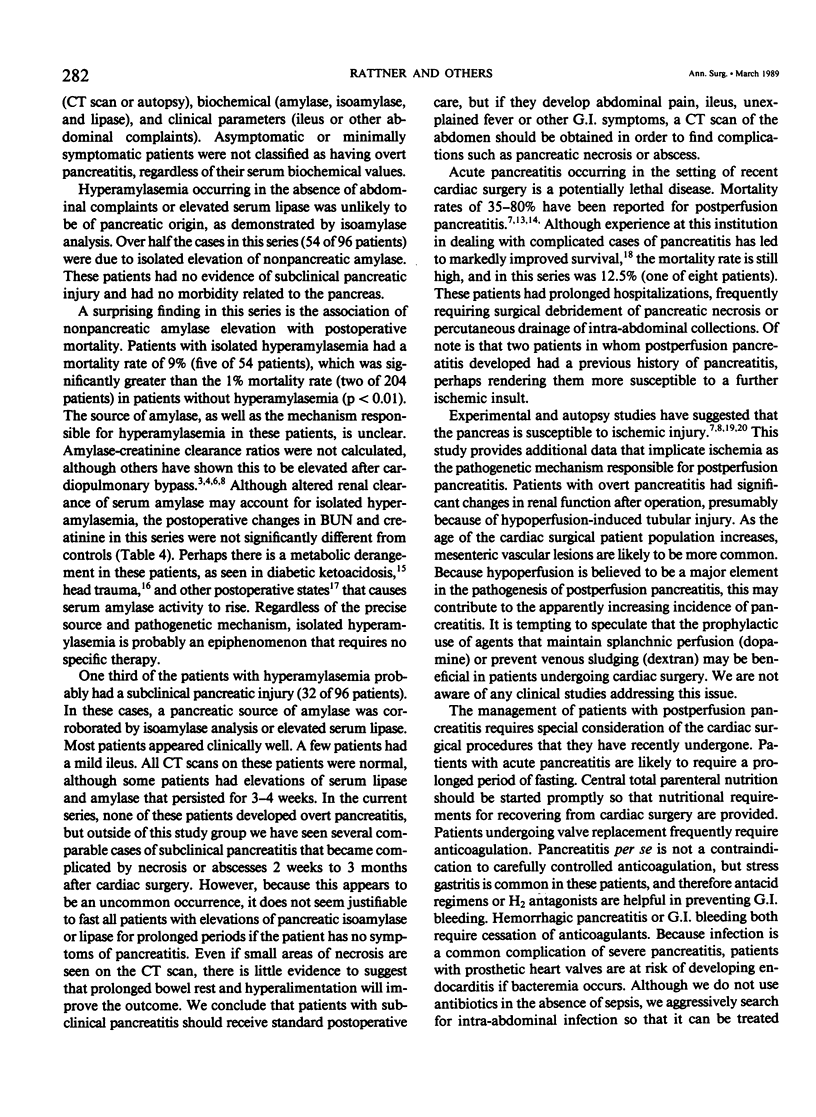
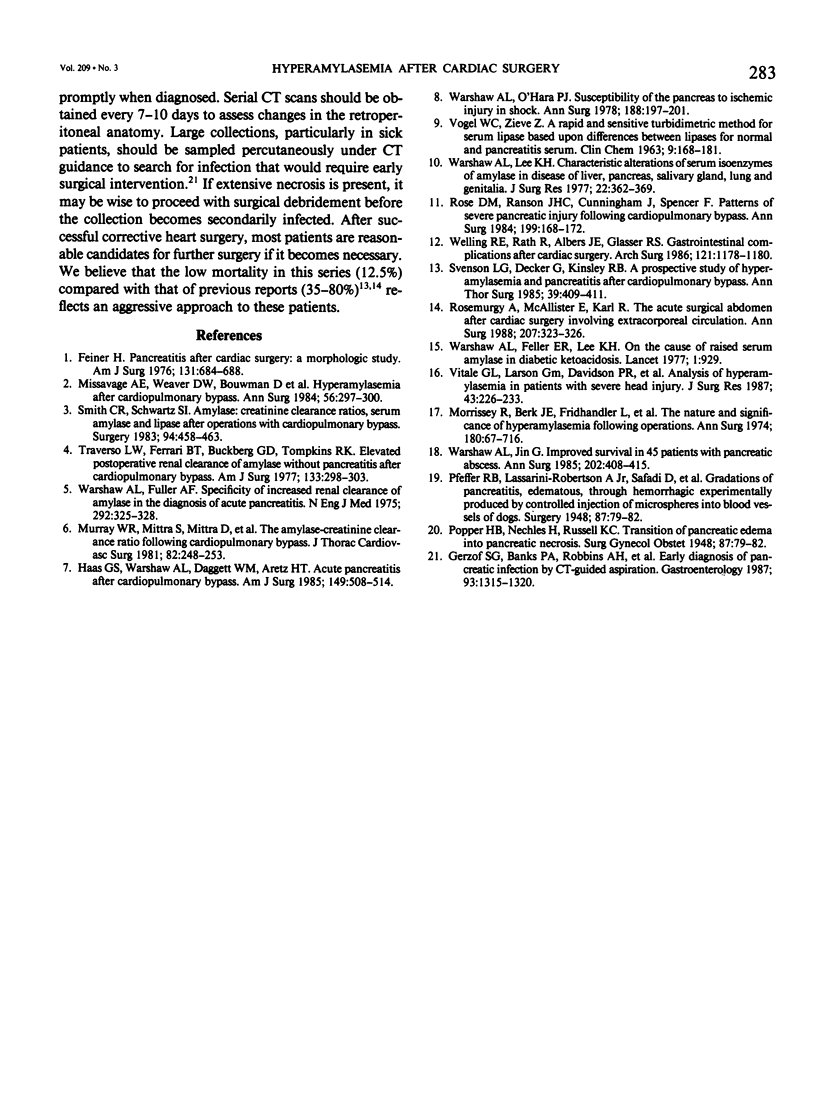
Images in this article
Selected References
These references are in PubMed. This may not be the complete list of references from this article.
- Feiner H. Pancreatitis after cardiac surgery; a morphologic study. Am J Surg. 1976 Jun;131(6):684–688. doi: 10.1016/0002-9610(76)90178-1. [DOI] [PubMed] [Google Scholar]
- Gerzof S. G., Banks P. A., Robbins A. H., Johnson W. C., Spechler S. J., Wetzner S. M., Snider J. M., Langevin R. E., Jay M. E. Early diagnosis of pancreatic infection by computed tomography-guided aspiration. Gastroenterology. 1987 Dec;93(6):1315–1320. doi: 10.1016/0016-5085(87)90261-7. [DOI] [PubMed] [Google Scholar]
- Haas G. S., Warshaw A. L., Daggett W. M., Aretz H. T. Acute pancreatitis after cardiopulmonary bypass. Am J Surg. 1985 Apr;149(4):508–515. doi: 10.1016/s0002-9610(85)80048-9. [DOI] [PubMed] [Google Scholar]
- McIntosh T. K., Head V. A., Faden A. I. Alterations in regional concentrations of endogenous opioids following traumatic brain injury in the cat. Brain Res. 1987 Nov 10;425(2):225–233. doi: 10.1016/0006-8993(87)90505-1. [DOI] [PubMed] [Google Scholar]
- Missavage A. E., Weaver D. W., Bouwman D. L., Parnell V., Wilson R. F. Hyperamylasemia after cardiopulmonary bypass. Am Surg. 1984 Jun;50(6):297–300. [PubMed] [Google Scholar]
- Morrissey R., Berk J. E., Fridhandler L., Pelot D. The nature and significance of hyperamylasemia follwing operation. Ann Surg. 1974 Jul;180(1):67–71. doi: 10.1097/00000658-197407000-00009. [DOI] [PMC free article] [PubMed] [Google Scholar]
- Murray W. R., Mittra S., Mittra D., Roberts L. B., Taylor K. M. The amylase-creatinine clearance ratio following cardiopulmonary bypass. J Thorac Cardiovasc Surg. 1981 Aug;82(2):248–253. [PubMed] [Google Scholar]
- Rose D. M., Ranson J. H., Cunningham J. N., Jr, Spencer F. C. Patterns of severe pancreatic injury following cardiopulmonary bypass. Ann Surg. 1984 Feb;199(2):168–172. doi: 10.1097/00000658-198402000-00006. [DOI] [PMC free article] [PubMed] [Google Scholar]
- Rosemurgy A. S., McAllister E., Karl R. C. The acute surgical abdomen after cardiac surgery involving extracorporeal circulation. Ann Surg. 1988 Mar;207(3):323–326. doi: 10.1097/00000658-198803000-00017. [DOI] [PMC free article] [PubMed] [Google Scholar]
- Smith C. R., Schwartz S. I. Amylase:creatinine clearance ratios, serum amylase, and lipase after operations with cardiopulmonary bypass. Surgery. 1983 Sep;94(3):458–463. [PubMed] [Google Scholar]
- Svensson L. G., Decker G., Kinsley R. B. A prospective study of hyperamylasemia and pancreatitis after cardiopulmonary bypass. Ann Thorac Surg. 1985 May;39(5):409–411. doi: 10.1016/s0003-4975(10)61945-5. [DOI] [PubMed] [Google Scholar]
- Traverso L. W., Ferrari B. T., Buckberg G. D., Tompkins R. K. Eelvated postoperative renal clearance of amylase without pancreatitis after cardiopulmonary bypass. Am J Surg. 1977 Mar;133(3):298–303. doi: 10.1016/0002-9610(77)90532-3. [DOI] [PubMed] [Google Scholar]
- VOGEL W. C., ZIEVE L. A rapid and sensitive turbidimetric method for serum lipase based upon differences between the lipases of normal and pancreatitis serum. Clin Chem. 1963 Apr;9:168–181. [PubMed] [Google Scholar]
- Vitale G. C., Larson G. M., Davidson P. R., Bouwman D. L., Weaver D. W. Analysis of hyperamylasemia in patients with severe head injury. J Surg Res. 1987 Sep;43(3):226–233. doi: 10.1016/0022-4804(87)90075-8. [DOI] [PubMed] [Google Scholar]
- Warshaw A. L., Feller E. R., Lee K. H. On the cause of raised serum-amylase in diabetic ketoacidosis. Lancet. 1977 Apr 30;1(8018):929–931. doi: 10.1016/s0140-6736(77)92225-5. [DOI] [PubMed] [Google Scholar]
- Warshaw A. L., Fuller A. F., Jr Specificity of increased renal clearance of amylase in diagnosis of acute pancreatitis. N Engl J Med. 1975 Feb 13;292(7):325–328. doi: 10.1056/NEJM197502132920701. [DOI] [PubMed] [Google Scholar]
- Warshaw A. L., Jin G. L. Improved survival in 45 patients with pancreatic abscess. Ann Surg. 1985 Oct;202(4):408–417. doi: 10.1097/00000658-198510000-00002. [DOI] [PMC free article] [PubMed] [Google Scholar]
- Warshaw A. L., Lee K. H. Characteristic alterations of serum isoenzymes of amylase in diseases of liver, pancreas, salivary gland, lung, and genitalia. J Surg Res. 1977 Apr;22(4):362–369. doi: 10.1016/0022-4804(77)90158-5. [DOI] [PubMed] [Google Scholar]
- Warshaw A. L., O'Hara P. J. Susceptibility of the pancreas to ischemic injury in shock. Ann Surg. 1978 Aug;188(2):197–201. doi: 10.1097/00000658-197808000-00012. [DOI] [PMC free article] [PubMed] [Google Scholar]
- Welling R. E., Rath R., Albers J. E., Glaser R. S. Gastrointestinal complications after cardiac surgery. Arch Surg. 1986 Oct;121(10):1178–1180. doi: 10.1001/archsurg.1986.01400100090017. [DOI] [PubMed] [Google Scholar]



